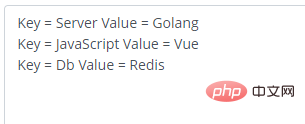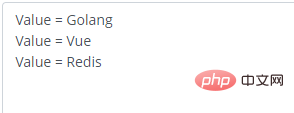There are several ways to loop through the map in golang
There is one way to loop through the map in golang, which is to use the "for range" statement. "for range" is a unique iteration structure of the Go language. The syntax is "for key, value := range mapName{...}". The first one returned is the key of the map, and the second one returned is the key of the map. value; if only one return parameter is accepted, then the key of the map is returned.

The operating environment of this tutorial: Windows 7 system, GO version 1.18, Dell G3 computer.
The traversal of map in Go language can only use the form of for range. The first one returned by the for range loop is the key of the map, and the second one returned is the value of the map.
Use for range to traverse the map. If we only use one return parameter to accept, then the key of the map is returned. Therefore, the map is unordered, so the order of the results obtained by each traversal of the same map is likely to be inconsistent.
for range loop traversal map syntax
Traverse map key and value
for key, value := range mapName{
...
}Use The for range loop traverses the map with the variable name mapName, where key is the key of the map and value is the value corresponding to the key of the map.
Traverse the keys of the map
for key := range mapName{
...
}When using the for range loop to traverse the map, if only one return value is accepted, then the map is returned key.
Traverse the value of the map
for _, value := range mapName{
...
}If we just want to get all the elements of the map, then we can use_ Ignore the value of key; use _ to change unnecessary keys to anonymous variable form. .
Example of for range looping through map
Example 1: Use for range to loop through map and obtain the KEY and VALUE of map
package main
import (
"fmt"
)
func main() {
//使用 for range 循环遍历 map,获取 map 的 KEY 和 VALUE
mapHaiCoder := map[string]string{
"Server":"Golang",
"JavaScript":"Vue",
"Db":"Redis",
}
for key, value := range mapHaiCoder{
fmt.Println("Key =", key, "Value =", value)
}
}
Example 2: Use for range to loop through all the keys of the map
package main
import (
"fmt"
)
func main() {
//使用 for range 循环遍历 map,获取 map 的 KEY 和 VALUE
mapHaiCoder := map[string]string{
"Server":"Golang",
"JavaScript":"Vue",
"Db":"Redis",
}
for key := range mapHaiCoder{
fmt.Println("Key =", key, "Value =", mapHaiCoder[key])
}
}
Example 3: Traverse the values of the map
If We just want to get all the elements of the map, then we can use _ to ignore the value of the key
package main
import (
"fmt"
)
func main() {
//使用 for range 循环遍历 map,获取 map 的 KEY 和 VALUE
mapHaiCoder := map[string]string{
"Server":"Golang",
"JavaScript":"Vue",
"Db":"Redis",
}
for _, value := range mapHaiCoder{
fmt.Println("Value =", value)
}
}
Go video tutorial,Programming Teaching】
The above is the detailed content of There are several ways to loop through the map in golang. For more information, please follow other related articles on the PHP Chinese website!

Hot AI Tools

Undresser.AI Undress
AI-powered app for creating realistic nude photos

AI Clothes Remover
Online AI tool for removing clothes from photos.

Undress AI Tool
Undress images for free

Clothoff.io
AI clothes remover

Video Face Swap
Swap faces in any video effortlessly with our completely free AI face swap tool!

Hot Article

Hot Tools

Notepad++7.3.1
Easy-to-use and free code editor

SublimeText3 Chinese version
Chinese version, very easy to use

Zend Studio 13.0.1
Powerful PHP integrated development environment

Dreamweaver CS6
Visual web development tools

SublimeText3 Mac version
God-level code editing software (SublimeText3)

Hot Topics
 1667
1667
 14
14
 1426
1426
 52
52
 1328
1328
 25
25
 1273
1273
 29
29
 1255
1255
 24
24
 How to solve the user_id type conversion problem when using Redis Stream to implement message queues in Go language?
Apr 02, 2025 pm 04:54 PM
How to solve the user_id type conversion problem when using Redis Stream to implement message queues in Go language?
Apr 02, 2025 pm 04:54 PM
The problem of using RedisStream to implement message queues in Go language is using Go language and Redis...
 What should I do if the custom structure labels in GoLand are not displayed?
Apr 02, 2025 pm 05:09 PM
What should I do if the custom structure labels in GoLand are not displayed?
Apr 02, 2025 pm 05:09 PM
What should I do if the custom structure labels in GoLand are not displayed? When using GoLand for Go language development, many developers will encounter custom structure tags...
 Which libraries in Go are developed by large companies or provided by well-known open source projects?
Apr 02, 2025 pm 04:12 PM
Which libraries in Go are developed by large companies or provided by well-known open source projects?
Apr 02, 2025 pm 04:12 PM
Which libraries in Go are developed by large companies or well-known open source projects? When programming in Go, developers often encounter some common needs, ...
 Golang's Purpose: Building Efficient and Scalable Systems
Apr 09, 2025 pm 05:17 PM
Golang's Purpose: Building Efficient and Scalable Systems
Apr 09, 2025 pm 05:17 PM
Go language performs well in building efficient and scalable systems. Its advantages include: 1. High performance: compiled into machine code, fast running speed; 2. Concurrent programming: simplify multitasking through goroutines and channels; 3. Simplicity: concise syntax, reducing learning and maintenance costs; 4. Cross-platform: supports cross-platform compilation, easy deployment.
 In Go programming, how to correctly manage the connection and release resources between Mysql and Redis?
Apr 02, 2025 pm 05:03 PM
In Go programming, how to correctly manage the connection and release resources between Mysql and Redis?
Apr 02, 2025 pm 05:03 PM
Resource management in Go programming: Mysql and Redis connect and release in learning how to correctly manage resources, especially with databases and caches...
 Do I need to install an Oracle client when connecting to an Oracle database using Go?
Apr 02, 2025 pm 03:48 PM
Do I need to install an Oracle client when connecting to an Oracle database using Go?
Apr 02, 2025 pm 03:48 PM
Do I need to install an Oracle client when connecting to an Oracle database using Go? When developing in Go, connecting to Oracle databases is a common requirement...
 How to ensure concurrency is safe and efficient when writing multi-process logs?
Apr 02, 2025 pm 03:51 PM
How to ensure concurrency is safe and efficient when writing multi-process logs?
Apr 02, 2025 pm 03:51 PM
Efficiently handle concurrency security issues in multi-process log writing. Multiple processes write the same log file at the same time. How to ensure concurrency is safe and efficient? This is a...
 Golang vs. Python: Performance and Scalability
Apr 19, 2025 am 12:18 AM
Golang vs. Python: Performance and Scalability
Apr 19, 2025 am 12:18 AM
Golang is better than Python in terms of performance and scalability. 1) Golang's compilation-type characteristics and efficient concurrency model make it perform well in high concurrency scenarios. 2) Python, as an interpreted language, executes slowly, but can optimize performance through tools such as Cython.




